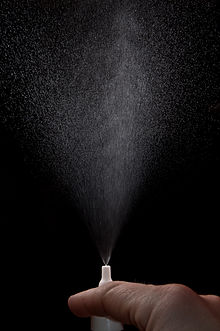

A spray bottle is a bottle that can squirt, spray or mist fluids.
History
While spray bottles existed long before the middle of the 20th century, they used a rubber bulb which was squeezed to produce the spray; the quickly-moving air siphoned fluid from the bottle. The rapid improvement in plastics after World War II increased the range of fluids that could be dispensed, and reduced the cost of the sprayers because assembly could be fully automated.
The Drackett company, manufacturers of Windex glass cleaner, was a leader in promoting spray bottles. Roger Drackett raised soybeans, converted the soybeans to plastic using technology purchased from Henry Ford, and was an investor in the Seaquist company, an early manufacturer of sprayers and closures. Initially, the brittle nature of early plastics required that sprayers be packaged in a cardboard box, and the sprayer inserted in the glass Windex bottle by the consumer. The cost in the manufacturing sprayers was also a factor; consumers would reuse the sprayers with bottle after bottle of glass cleaner. As plastics improved and the cost of sprayers dropped, manufacturers were able to ship products with the sprayer already in the bottle.
In the late 1960s, spray bottles with trigger-style actuators appeared and quickly became popular, as this design was less fatiguing to use. The original pump-style bottle remained more popular for applications like non-aerosol deodorants, where size was a factor and repeated pumps were not required.
Modern spray bottles
Unlike the rubber bulb dispenser which primarily moved air with a small amount of fluid, modern spray bottles use a positive displacement pump that acts directly on the fluid. The pump draws liquid up a siphon tube from the bottom of the bottle and forces it through a nozzle. Depending on the sprayer, the nozzle may or may not be adjustable, so as to select between squirting a stream, aerosolizing a mist, or dispensing a spray.
In a spray bottle, the dispensing is powered by the user's efforts, as opposed to the spray can, in which the user simply actuates a valve and product is dispensed under pressure.
Several designs have been developed. Some of the pumping mechanisms of spray bottles are similar to those of pump dispensers which are used for more viscous products.
Examples
-
 An aluminum bottle with spray attachment
An aluminum bottle with spray attachment
-
 Two spray bottles clipped together
Two spray bottles clipped together
-
 water spray
water spray
-
 lawn spray bottle with hose attachment
lawn spray bottle with hose attachment
-
Nasal spray
-
 Perfume atomizer
Perfume atomizer
See also
- Aerosol spray – Dispensing system of an aerosol mistPages displaying short descriptions of redirect targets
- Atomizer nozzle – Device that facilitates dispersion of liquid into a sprayPages displaying short descriptions of redirect targets
- List of bottle types, brands and companies
- Nebulizer – Drug delivery device
- Pesticide application – Delivery of pesticides
- Spray nozzle – Device that facilitates dispersion of liquid into a spray
- Squeeze bottle – Type of container
- Water gun – Type of toy gun designed to shoot water
References
- US4274560A, Emson, "Atomizing pump dispenser", published 1981
- USD406052S, Dumont, "Bottle with trigger pump", published 1979
- US8453950B2, Dennis, "Hose sprayer with integral dip tube", published 2011
- Cheng, Y S (2001), "Characterization of Nasal Spray Pumps and Deposition Pattern in a Replica of the Human Nasal Airway", Journal of Aerosol Medicine, 14 (2): 267–280, doi:10.1089/08942680152484199, PMID 11681658, retrieved 2 June 2018
- Yam, K. L., "Encyclopedia of Packaging Technology", John Wiley & Sons, pp 275–276, 2009, ISBN 978-0-470-08704-6
- Soroka, W, "Fundamentals of Packaging Technology", IoPP, 2002, ISBN 1-930268-25-4
Standards, ASTM International
- D3890 Standard Test Method for Number of Strokes to Prime a Mechanical Pump Dispenser
- D4041 Standard Practice for Determining Spray Patterns of Mechanical Pump Dispensers
- D4333 Test Method for the Compatibility of Mechanical Pump Dispenser Components
- D4334 Standard Test Method for the Determination of the Dip Tube Retention of a Mechanical Pump Dispenser
- D4335 Standard Test Method for Determination of Component Retention of a Mechanical Pump Dispenser
- D4336 Standard Test Methods for Determination of the Output Per Stroke of a Mechanical Pump Dispenser
- D6534 Standard Test Method for Determining the Peak Force-to-Actuate a Mechanical Pump Dispenser
- D6535 Standard Test Method for Determining the Dip Tube Length of a Mechanical Pump Dispenser
- D6536 Standard Test Method for Measuring the Dip Tube Length of a Mechanical Pump Dispenser
- D6633 Standard Test Method for Basic Functional Stability of a Mechanical Pump Dispenser
- D6654 Standard Test Method for Basic Storage Stability of a Mechanical Pump Dispenser
External links
- "How do spray bottles pump fluid?". HowStuffWorks. 2001-07-05. Retrieved 2024-06-19.